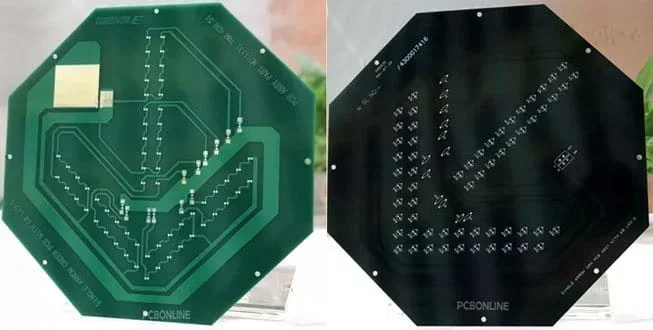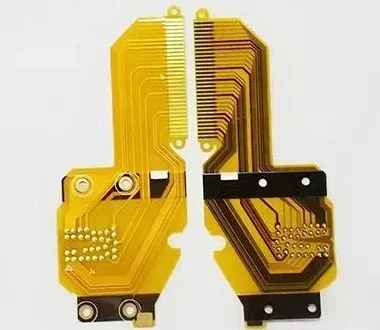Double-sided PCBs are printed circuit boards having two component-mounting sides, and they are common for electronics manufacturing. The PCB laminates for double-sided PCBs are double-sided. The top and bottom layers (layer refers to circuit layer) of double-sided PCBs are designed to solder with electronic components and are interconnected by plating-through holes (PTH).

In this article, you will learn about double-sided PCB types, manufacturing, and assembly from three parts.
Part 1: Introduction to Various Types of Double-Sided PCBs
Double-sided PCBs are double-layer or multilayer. Based on the PCB substrate materials, we classify double-sided PCB types below:
Double-Sided FR4 PCB
Double-sided FR4 PCBs are the most common double-sided PCBs. The FR4 material is epoxy glass fiber, which has good bonding and mechanical performances and small contraction. The FR4 is used as the PCB substrate and prepreg (PP) layers that insulate copper layers.
The maximum temperature at which the FR4 material can remain rigid is glass transition temperature (Tg), which is about 40℃ higher than the PCB's maximum withstand temperature. Usually, the Tg of common double-sided FR4 PCB is 135℃, and high Tg FR4 PCBs have a Tg equal to or more than 180+℃.
The stack-up of a four-layer double-sided FR4 PCB from the top to the bottom is copper > PP > copper > FR4 substrate > copper > PP > copper.
Double-Sided PTFE PCB
Double-sided PTFE PCBs are double-sided high-frequency PCBs. The PTFE material is a soft plastic, which has low dielectric loss and a small dielectric constant. PTFE is also called Teflon (a famous PTFE product brand), and the famous PTFE laminates brand is Rogers. Besides Rogers laminates, the other laminate brands for high-frequency PCBs include Arlon, Taizhou Wangling, Nelco, and Taconic.
![]()
In double-sided high-frequency PCB design, circuit loops and sharp corners should be avoided. Usually, the trace corners have a 45℃ angle. The distance between adjacent traces on the same layer or adjacent layers should be as far as possible to avoid coupling. And the digital signals should not interfere with other signals.
The critical to double-sided high-frequency PCBs is the laminate. The PTFE laminate should have small thermal expansion and contraction. The manufacturer PCBONLINE has PTFE laminates in stock within 45 days of storage, and you can have double-sided high-frequency PCBs manufactured as soon as possible.
Double-Sided Metal Core PCB
Double-sided metal core PCBs include double-sided aluminum PCBs and double-sided copper core PCBs. Currently, they are mainly used for LED lighting applications that require great thermal dissipation.
Double-sided metal core PCBs are more costly than single-sided metal core PCBs. The reason is that we need to drill PTHs on the aluminum/copper core. To insulate the metal core and PTHs, we have to drill holes with apertures 1mm larger than the design and fill the holes with resin. Then we drill PTHs in the resin and electroplate copper. The other processes are the same as single-sided PCBs.
![]()
The stack-up of a two-layer double-sided aluminum PCB from the top to the bottom is copper > dielectric > aluminum substrate > dielectric > copper.
Double-Sided Flexible PCB and Rigid-Flex PCB
Double-sided flexible PCBs and rigid-flex PCBs have lighter weight and smaller sizes than other double-sided PCBs. They can route wires and connect in 3-D space and roll or fold.

The base material of double-sided flexible PCBs and rigid-flex PCBs is polyimide (PI) or poster (PET). PI and PET are used as the substrate and dielectric layer of the double-sided flexible PCBs and the rigid-flex PCBs' flex section.
The copper foil for flexible PCBs can be RA or ED copper, while for rigid-flex PCBs, it must be RA copper.
The color of double-sided flexible PCBs can be yellow, black, or white. From the manufacturer PCBONLINE, you can also have transparent flexible PCBs manufactured.
The stack-up of a three-layer flexible PCB from the top to the bottom is copper > PI > copper > PI > copper.
Double-Sided Ceramic PCB
Double-sided ceramic PCBs include double-sided AlN PCBs and alumina PCBs. AlN and alumina have great thermal conductivity, stable chemical performances, and small thermal expansion, and double-sided ceramic PCBs are used for high-power applications. Besides, AlN PCBs have a close thermal expansion coefficient with semiconductors (ICs), so IGBT boards usually are AlN PCBs.
![]()
From the manufacturer PCBONLINE, you can have single-sided and double-sided ALN PCBs and alumina PCBs from one to four layers. Besides, you can also have glass PCBs manufactured.
The stack-up of a two-layer double-sided AlN PCB from the top to the bottom is copper > AlN substrate > copper or copper> dielectric layer > AlN substrate > dielectric layer > copper.
Apart from the above types of double-sided PCBs, you can have hybrid double-sided PCBs manufactured.
Part 2: Double-Sided PCB Manufacturing and Assembly
Fabrication and assembly of doubles-sided PCBs do have not many differences from single-sided PCBs. The differences between double-sided PCB manufacturing and assembly between single-sided PCBs are below:
- Double-sided PCBs use double-sided laminate, while single-sided PCBs use single-sided laminate.
- Double-sided PCB manufacturing requires drilling plating through holes and electroplating holes with copper.
- Double-sided metal core PCB manufacturing requires additional drilling and resin filling to insulate the metal core and PTHs.
- Double-sided PCB assembly requires SMT assembly twice, each time for assembly on one side.
PCBONLINE, founded in 1999, has two large advanced manufacturing bases and one PCB assembly factory. If you need double-sided PCB manufacturing and assembly, the manufacturer PCBONLINE can provide you with one-stop services from prototyping to bulk production.
![]()
By working with PCBONLINE for double-sided PCBs, you can enjoy:
- Strong manufacturing capabilities - double-sided PCBs from 2 to up to 60 layers, copper thickness from 1/3oz to up to 14oz, and high-density available.
- Various double-sided PCB options - FR4, PTFE, aluminum, copper, PI, PET, ceramic, and hybrid substrates.
- One-on-one engineering support and design assistance throughout your double-sided PCB project.
- Double-side PCB manufacturing and assembly, including electronic components, certified with ISO, IATF, IPC, RoHS, REACH, and UL.
If you let the PCBONLINE team take part in your project from the beginning to the developing phase, we can work together with your engineer to avoid possible complex issues in the post-PCB assembly phase. Besides, our CAM engineer can help reduce the manufacturing costs by the optimum PCB design. Please feel free to contact PCBONLINE by email at info@pcbonline.com to send your Gerber and get a quote.
Part 3: FAQs about Double-Sided PCB
Question 1. When is a double-sided PCB needed instead of a single-sided PCB?
A PCB can be single-sided or double-sided depending on your product's needs. You can design blind/buried vias to make high-density circuits on a single-sided PCB to increase circuit density, but you can also make a double-sided PCB to achieve the same functions and reduce manufacturing complexity. If you need more circuit density, you can also design the double-sided board to be HDI.
Question 2. What are the advantages of double-sided PCBs?
Double-sided PCBs have two component mounting sides, so they can mount a large number of electronic components. Besides, double-sided PCBs provide more circuit space and thus more design possibilities. Compared with single-sided PCBs that achieve the same functions, a double-sided PCB has a smaller size.
Question 3. what is the challenge of double-sided PCBs?
Overheating is the challenge of double-sided PCBs because the substrate is inside the PCB and there are more components. But our CAM engineer with more than 20 years of experience can help solve the thermal conductivity issue. For example, we can separate the thermal dissipation and electrical function networks for thermal management.
Conclusion
All types of PCBs can be designed and manufactured to be double-sided. A double-sided PCB can mount more electronic components and achieve more functions than single-sided PCBs. If you need double-sided PCB manufacturing and assembly, work with the one-stop manufacturer PCBONLINE who won't let you down.
© This article is an original work of the PCBONLINE team. Please indicate the author PCBONLINE if you reprint. If the article is reproduced without permission or indicating the author's source, PCBONLINE reserves the right to investigate the infringement.




